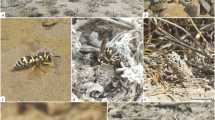Summary
A large number of associated organisms have been found in nest ofMyrmecia; the following orders and numbers of species, in brackets, are represented:Anura (1); Araneae (9); Acarina (1); Blattodea (3); Coleoptera (20+); Collembola (3); Diptera (1); Hemiptera (2); Hymenoptera (14); Isoptera (2); Lepidoptera (4); Neuroptera (1); Orthoptera (2); Thysanura (4+); Isopoda (13) and Nematoda (1).
Most abundant were specimens of Collembola and Isopoda which were found in the majority of nests; these occurred principally as scavengers. The termite species and two ant species were found in colonies co-inhabiting the large earthen mounds ofMyrmecia. Some of the Coleoptera and Diptera species occurred as larvae in the debris left in chambers, whereas many of the adult beetles were present as prey. Noteworthy were the several occurrences of large Carabidae larvae in the nests of fourMyrmecia species.
Résumé
Un grand nombre d'organismes ont été trouvés dans les nids deMyrmecia. Les ordres suivants (avec le nombre d'espèces) sont représentés: Anura (1); Araneae (9); Acarina (1); Blattodea (3); Coleoptera (20+); Collembola (3); Diptera (1); Hemiptera (2); Hymenoptera (14); Isoptera (2); Lepidoptera (4); Neuroptera (1); Orthoptera (2); Thysanura (4+); Isopoda (13) et Nematoda (1).
Les plus fréquents sont des Collemboles et des Isopodes, qui ont été trouvés dans la majorité des nids; ils sont surtout détritivores. Des Termites et deux espèces de Fourmis cohabitent, sous forme de sociétés, dans les grands dômes de terre desMyrmecia. Certains des Coléoptères et des Diptères se trouvent, à l'état de larves, dans les chambres à débris, tandis que beaucoup des Coléoptères adultes constituent des proies. Il y a lieu de souligner la présence répétée de grandes larves deCarabidae dans les nids de quatre espèces deMyrmecia.
Similar content being viewed by others
References
Barbour (T.) andLoveridge (A.), 1929. — On some Australian toads of the genusPseudophyrne. Copeia, 170, 12–15.
Forel (A.), 1890. — Un parasite de laMyrmecia forficata F.,C. R. Soc. Ent. Belg., 1, 3 p.
Freeland (J.), 1958. — The biology and social behaviour of the Australian bulldog ants. The Society of Entomologists, Sydney, Circular No. 64, 21–33.
Gray (B.), 1971a. — Notes on the biology of the ant speciesMyrmecia dispar (Clark) (Hymenoptera: Formicidae).Ins. Soc., 18, 71–80.—Gray (B.) 1971b. Notes on the field behaviour of two ant speciesMyrmecia desertorum Wheeler andMyrmecia dispar (Clark) (Hymenoptera: Formicidae).Ins. Soc., 18, 81–94.—Gray (B.), 1974. Nest structure and populations ofMyrmecia (Hymenoptera: Formicidae), with observations on the capture of prey.Ins. Soc., 21. 107–120.
Haskins (C. P.) andHaskins (E. F.), 1950. — Notes on the biology and social behavior of the archaic ponerine ants of the generaMyrmecia andPromyrmecia.Ann. Ent. Soc. Amer., 43, 461–491.
Lea (A. M.), 1905. — Art. XVI. OnNepharis and other ants' nest beetles taken by Mr. J. C. Goudie at Birchip.Roy. Soc. Victoria, 17, 371–385.—Lea (A. M.) 1910a. Art. XX: Australian and Tasmanian Coleoptera inhabiting or resorting to the nests of ants, bees and termites.Proc. Roy. Soc. Victoria, (N.S.), 23, 116–229.—Lea (A. M.) 1910b. The guests of ants, bees and termites.Victorian Naturalist, 27, 50–56.—Lea (A. M.) 1912. Art. IV. Australian and Tasmanian Coleoptera inhabiting or resorting to the nests of ants, bees and termites. Supplement.Proc. Roy. Soc. Victoria (N.S.), 25, 31–78.
Vandel (A.), 1973, — Les isopodes terrestres de l'Australie, étude systématique et biogéographique. Mémoires Muséum national d'Histoire naturelle, Paris, Sér. A,Zoology, 82, 171 p., 1 map.
Wheeler (W. M.), 1910. — Ants. Their Structure, Development and Behavior.Columbia University Press, Publ., New York, 663 p.
Wilson (E. O.), 1971. — The Insect Societies. The Belknap Press ofHarvard University Press, Publ., Cambridge, Mass., 548 p.
Author information
Authors and Affiliations
Rights and permissions
About this article
Cite this article
Gray, B. Associated fauna found in nests ofMyrmecia (Hymenoptera: Formicidae). Ins. Soc 21, 289–299 (1974). https://doi.org/10.1007/BF02226920
Received:
Accepted:
Issue Date:
DOI: https://doi.org/10.1007/BF02226920




